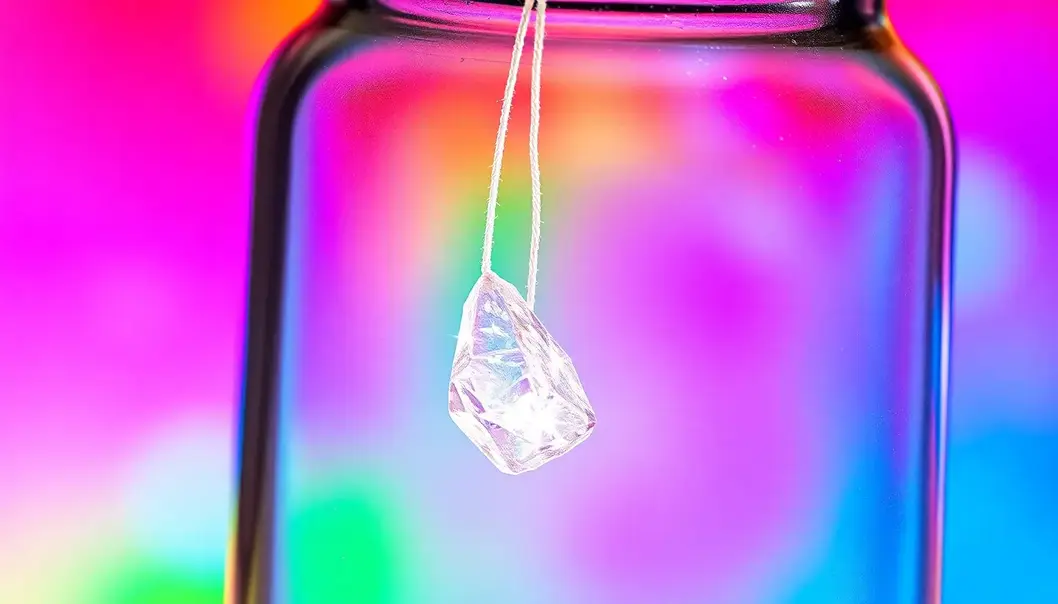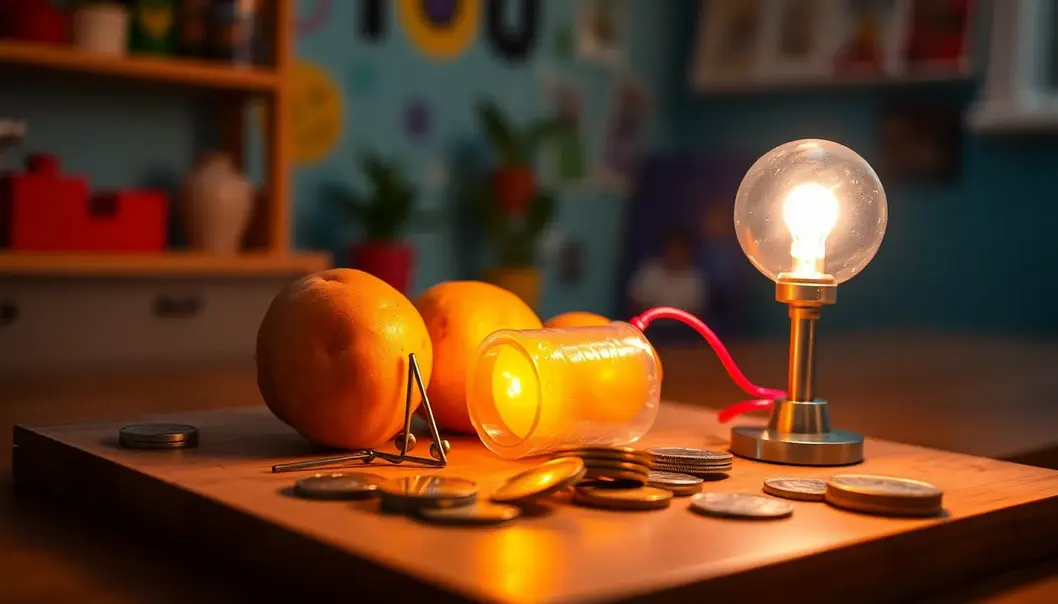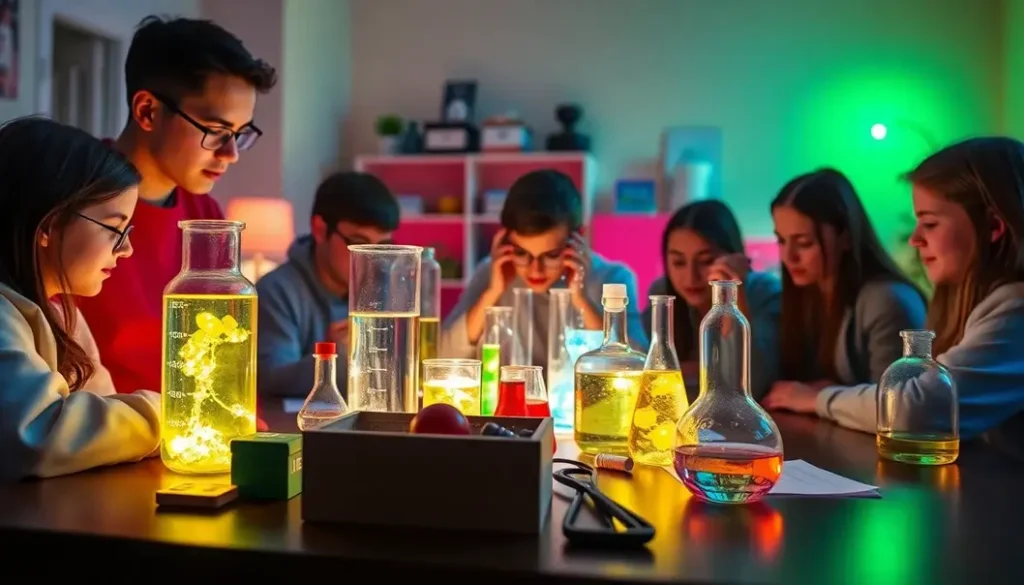Bundled in the cozy comfort of your own home, you can transform your living room into an electrifying lab. Whether you’re aiming to impress friends or simply feed your curiosity, these science experiments are perfect for channeling your inner mad (but friendly) scientist. Packed with possibilities and a whole lot of fun, these experiments help you grasp scientific concepts without the need for a complex lab setup. Prepare to dazzle with sparkling crystal creations and heart-pounding potato batteries. Ready to mix, boom, and sparkle? Dive in and see how science at home can be a wonderfully chaotic and enlightening ride!
Dazzling Crystal Creations

Transforming simple sugar cubes into glittering crystals is an exciting chemistry experiment right in your living room. It reveals the magic of crystallization, a process that combines art and science.
Start by crushing sugar cubes using the back of a spoon. The powdered sugar dissolves more easily, preparing it for the next step. Once ready, boil a pot of water. Heat is crucial for creating a supersaturated solution, where sugar molecules jostle to dissolve within a limited space, setting the stage for eventual crystal formation.
With the water boiling, begin adding the powdered sugar slowly, stirring constantly. Keep adding sugar until no more will dissolve. You’ll know you’ve achieved a supersaturated solution when the sugar begins settling at the bottom, refusing to dissolve despite vigorous stirring.
Carefully pour this solution into a clean glass. Tie a string to the center of a pencil and balance the pencil over the rim of the glass, allowing the string to dip into the solution. This string serves as a seed, upon which sugar molecules begin to crystallize, a perfect demonstration of nature’s ingenuity.
As the days pass, the liquid gradually cools, and the excess sugar that couldn’t dissolve at room temperature begins attaching to the string in intricate patterns. What’s fascinating is how variables like temperature, time, and even the type of sugar influence the crystalline structures that form.
Prepare to be patient. The transformation may take several weeks, but watching the crystals grow is a lesson in persistence and precision, hallmarks of scientific exploration. Tip: To speed up the process, avoid disturbing the glass. A calm, undisturbed environment encourages the most robust crystal growth.
There’s a sublime satisfaction in seeing vibrant sugar crystals fill your glass, a testament to your journey as a home scientist. It’s not only a fun project but also a gateway into the exploration of phenomena like saturation and evaporation, sparking curiosity and learning. Share your results with fellow home scientists and compare the unique patterns that emerge, adding a social dimension to your experiment.
For those who enjoy teaching and sharing pets-related content, you might find creating intriguing, accessible projects for all ages an engaging experience. You can learn more about unique engagement activities here.
Stay tuned for the next chapter, where we’ll explore the world of electrical energy using a humble potato as a power source!
Energizing Potato Battery

Imagine transforming a humble spud into a source of electrical energy. No advanced laboratory is needed—just a couple of potatoes, some household materials, and a dash of scientific curiosity. The potato battery experiment is an extraordinary journey into the realm of electrochemistry that not only sparks creativity but also fosters an understanding of fundamental scientific principles. Let’s embark on this electrifying adventure and see who can keep the glow of an LED light alive the longest!
The ingredients for this experiment are surprisingly simple: two potatoes, a galvanized nail, a copper coin, some wire, and an LED light. As you gather these items, consider the roles they play in your chemical circuit. Galvanized nails are typically coated in zinc, which acts as an electrode, while copper coins serve as the second type of electrode. Potatoes contain phosphoric acid, which facilitates the flow of ions and completes the circuit, allowing electricity to flow.
Setting up your potato-powered circuit is straightforward but intriguing. Start by inserting a galvanized nail into each potato. Next, lodge a copper coin into each potato, ensuring that it does not touch the nail. Connect the nail of the first potato to the copper coin of the second with a wire. Now, take another wire and connect the coin of the first potato to one end of the LED light. Finish the circuit by attaching the other end of the LED light to the nail of the second potato. If all connections are secure, you should be rewarded with the glow of the LED, proof that you have harnessed electricity from potatoes.
The magic behind this process lies in the transfer of electrons due to the chemical reaction between the zinc and the phosphoric acid in the potato. This reaction releases electrons, which then flow through the wires to power your LED. Over time, however, the LED may begin to dim. This provides a perfect opportunity for experimentation: try replacing the potatoes with fresh ones and observe how the brightness changes. Such variations can spark intriguing competitions: who can keep the light glowing the longest? Who can make it shine brighter?
Engaging in potato battery experiments not only illuminates the dark but also elucidates the concepts of chemical reactions, electron flow, and circuit design. This not only serves as an exciting educational tool but also kindles a love for science and exploration among teens. Although it might not power your entire house, the knowledge and excitement generated by this experiment are boundless. Now, unleash your inner scientist and light up your world, one potato at a time!
Final words
These mind-blowing experiments not only prod your imagination but also shine a light on the joys of at-home science adventures. So grab some common household items, and let the excitement flow along with the electrons! Whether you’re growing dazzling crystals or lighting up the room with a potato battery, you’re bound to fall in love with science. Keep experimenting because the world is full of curiosities ready to be uncovered by you, the next scientific pioneer!
Ready to discover more experiments that will ignite your curiosity? Visit our complete guide to brilliant science experiments at home!
Learn more: https://www.home-science-experiments.com/guide
About us
Our platform offers a vast collection of DIY science experiments tailored for young enthusiasts. With detailed guides and video tutorials, embark on a journey to explore chemistry, physics, and biology right from your home. Perfect for sparking a passion for science!
